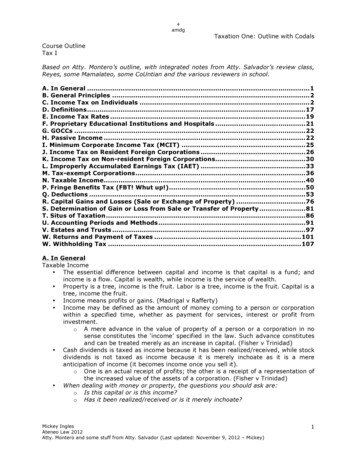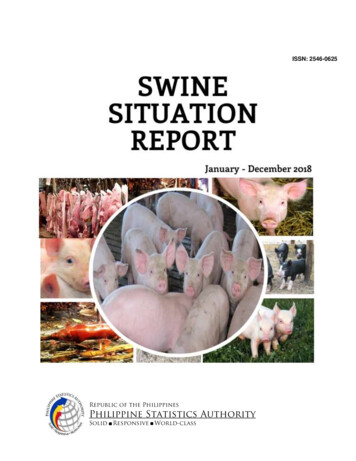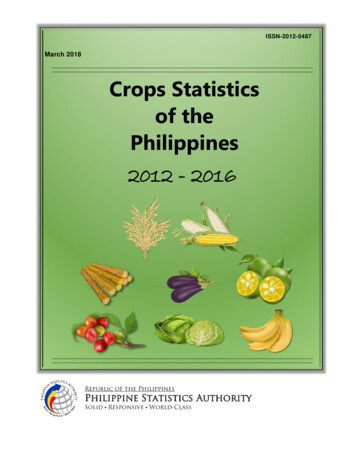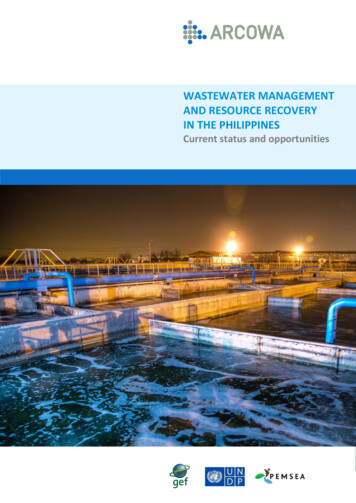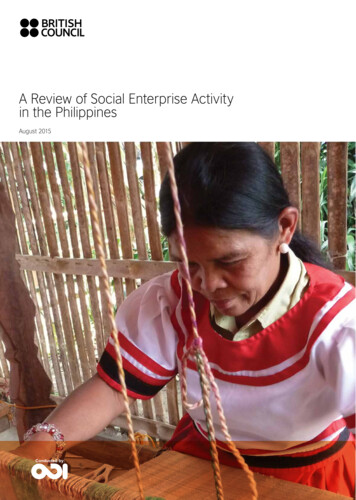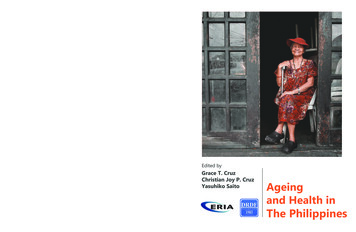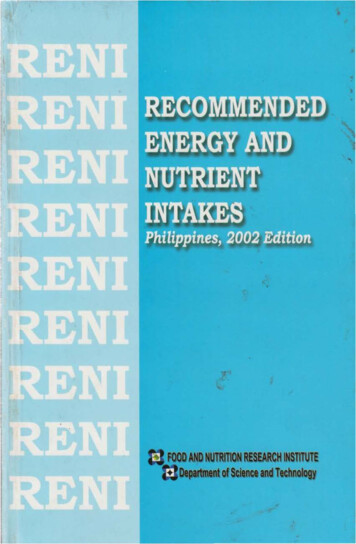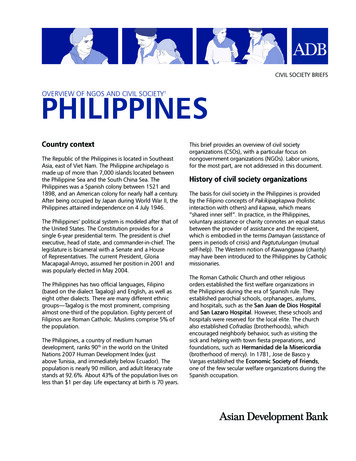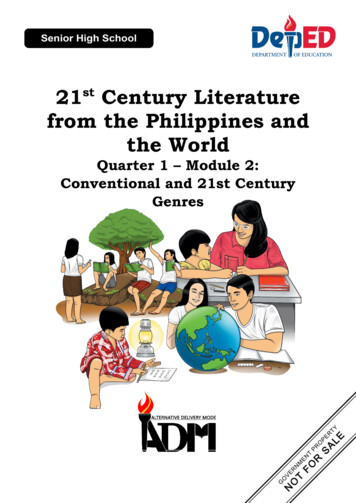
Transcription
21st Century Literaturefrom the Philippines andthe WorldQuarter 1 – Module 2:Conventional and 21st CenturyGenres
21st Century Literature from the Philippines and the WorldAlternative Delivery ModeQuarter 1 – Module 2: Conventional and 21st Century Literary GenresFirst Edition, 2020Republic Act 8293, section 176 states that: No copyright shall subsist in any work of theGovernment of the Philippines. However, prior approval of the government agency or officewherein the work is created shall be necessary for exploitation of such work for profit. Suchagency or office may, among other things, impose as a condition the payment of royalties.Borrowed materials (i.e., songs, stories, poems, pictures, photos, brand names, trademarks,etc.) included in this module are owned by their respective copyright holders. Every efforthas been exerted to locate and seek permission to use these materials from their respectivecopyright owners. The publisher and authors do not represent nor claim ownership overthem.Published by the Department of EducationSecretary: Leonor Magtolis BrionesUndersecretary: Diosdado M. San AntonioDevelopment Team of the ModuleWriters: Reivy L. Cadacio and Fritz A. CaturayEditors: Alson Rae F. Luna and Paula J. MartinezReviewers: Catherine A. Costoy, Abigail P. Asunto and Wenifreda S. DiquitIllustrator: Mary Grace S. Santos and Shaine Rita B. IncapasLayout Artist: Jennifer U. CruzManagement Team: Wilfredo E. CabralJob S. Zape Jr.Eugenio S. AdraoElaine T. BalaoganFe M. Ong-ongowanRommel C. BautistaElias A. Alicaya Jr.Ivan Brian L. InductivoElpidia B. BergadoNoel S. OrtegaJosephine M. MonzagaPrinted in the Philippines byDepartment of Education – Region IV-A CALABARZONOffice Address:Telefax:E-mail Address:Gate 2 Karangalan Village, Barangay San IsidroCainta, Rizal .gov.ph
21 Century Literaturefrom the Philippinesand the WorldstQuarter 1 – Module 2:Conventional and 21st CenturyGenres
Introductory MessageFor the facilitator:Welcome to the 21st Century Literature 11 Alternative Delivery Mode (ADM) Moduleon Conventional and 21st Century Genres.This module was collaboratively designed, developed, and reviewed by educatorsboth from public and private institutions to assist you, the teacher, or facilitator inhelping the learners meet the standards set by the K to 12 Curriculum whileovercoming their personal, social, and economic constraints in schooling.This learning resource hopes to engage the learners in guided and independentlearning activities at their own pace and time. Furthermore, this also aims to helplearners acquire the needed 21st-century skills while taking into considerationtheir needs and circumstances.Also, you will see this box in the body of the main text in this module:Notes to the TeacherThis contains helpful tips or strategiesthat will help you in guiding the learners.As a facilitator, you are expected to orient the learners on how to use this module,encourage and assist them as they do the tasks, and track their progress whileallowing them to manage their learnings.For the learner:Welcome to the 21st Century Literature 11 Alternative Delivery Mode (ADM) Moduleon Conventional and 21st Century Genres.The hands are one of the most symbolized parts of the human body. They are oftenused to depict skill, action, and purpose. Through your hands, you may learn,create, and accomplish. Hence, the hands in this learning resource signify thatyou, as a learner, are capable and empowered to successfully achieve the relevantcompetencies and skills at your own pace and time. Your academic success lies inyour own hands!This module was designed to provide you with fun and meaningful opportunitiesfor guided and independent learning. You will be enabled to process the contents ofthe learning resource while being an active learner.ii
This module has the following parts and corresponding icons:What I Need to KnowThis will give you an idea of the skills orcompetencies you are expected to learn inthe module.What I KnowThis part includes an activity that aims tocheck what you already know about thelesson to take. If you get all the answerscorrect (100%), you may decide to skip thismodule.What’s InThis is a brief drill or review to help you linkthe current lesson with the previous one.What’s NewIn this portion, the new lesson will beintroduced to you in various ways such as astory, a song, a poem, a problem opener, anactivity or a situation.What is ItThis section provides a brief discussion ofthe lesson. This aims to help you discoverand understand new concepts and skills.What’s MoreThis comprises activities for independentpractice to solidify your understanding andskills of the topic. You may check theanswers to the exercises using the AnswerKey at the end of the module.What I Have aph to be filled in toprocess what you learned from the lesson.What I Can DoThis section provides an activity which willhelp you transfer your new knowledge orskill into real life situations or concerns.AssessmentThis is a task which aims to evaluate yourlevel of mastery in achieving the learningcompetency.Additional ActivitiesIn this portion, another activity will be givento you to enrich your knowledge or skill ofthe lesson learned. This also tends retentionof learned concepts.Answer KeyThis contains answers to all activities in themodule.iii
At the end of this module you will also find:ReferencesThis is a list of all sources used indeveloping this module.The following are some reminders in using this module:1. Use the module with care. Do not put unnecessary mark/s on any part ofthe module. Use a separate sheet of paper in answering the exercises.2. Don’t forget to answer What I Know before moving on to the other activitiesincluded in the module.3. Read the instruction carefully before doing each task.4. Observe honesty and integrity in doing the tasks and checking youranswers.5. Finish the task at hand before proceeding to the next.6. Return this module to your teacher/facilitator once you are through with it.If you encounter any difficulty in answering the tasks in this module, do nothesitate to consult your teacher or facilitator. Always bear in mind that you arenot alone.We hope that through this material, you will experience meaningful learningand gain deep understanding of the relevant competencies. You can do it!iv
v
What I Need to KnowThis module is a standalone section that you can use based on your needsand interests to enhance your competency on how to differentiate thevarious 21st century literary genres and the ones from the original genres,citing their elements, structures and traditions.After going through this module, you are expected to:1. differentiate the 21st century literary genres, and the one’s from theoriginal genres;2. enumerate the elements, structures and traditions of each genre;3. appreciate the unique features of each genre.What I KnowChoose the letter of the best answer. Write the chosen letter on a separatesheet of paper.1. It is a genre of speculative fiction dealing with imaginative conceptssuch as futuristic science and technology, space travel, time travel,faster than light travel, a parallel universe and extra-terrestrial life.a. Digi-Fictionb. Doodle Fictionc. Science Fictiond. Creative Non-Fiction2. A literary genre which combines three media: book, movie/video andinternet website.a. Digi-Fictionb. Doodle Fictionc. Science Fictiond. Creative Non-Fiction1
3. A Literary presentation where the author incorporates doodle writingand drawings and handwritten graphics in place of the traditional fontSpanish Perioda. Digi-Fictionb. Doodle Fictionc. Science Fictiond. Creative Non-Fiction4. Stories told almost entirely in dialogue, simulating social networkexchanges.a. Chick Litb. Digi-Fictionc. Hyper Poetryd. Text-Talk Novel5. It is a genre fiction which addresses issues of modern womanhood,often humorously and lightheartedly.a. Chick Litb. Digi-Fictionc. Hyper Poetryd. Text-Talk Novel6. It is a website that contains short articles posted and changedregularly.a. Blogb. Flash Fictionc. Hyper Poetryd. Digi-Fiction7. Digital literature that uses links and includes parts that move ormutate.a. Blogb. Flash Fictionc. Hyper Poetryd. Digi-Fiction8. It is a comic book or book series published in Japan.a. Digi-Fictionb. Doodle Fictionc. Illustrated Noveld. Manga9. Stories characterized by their brevity. It could range from a word to athousand.a. Creative Nonfictionb. Flash Fictionc. Blogd. Hyper Poetry2
10. Narrative work in which a story is told using a comic form.a. Mangab. Digi-Fictionc. Graphic Noveld. Illustrated Novel11. 39 Clues book series by Scholastic, where stories are told using thecombination of book, video, and website, is an example of this literarygenre.a. Digi-Fictionb. Doodle Fictionc. Science Fictiond. Creative Non-Fiction12. Mashable by Pete Cashmore, where feature stories around the worldare posted and updated, is an example of this literary genre.a. Blogb. Flash Fictionc. Hyper Poetryd. Digi-Fiction13. A story that develops through a screenshot of SMS conversation likeVince and Kath by Jenny Ruth Almocera is an example of thisliterary genre.a. Chick Litb. Digi-Fictionc. Hyper Poetryd. Text-Talk Novel14. A story that uses literary techniques to create accurate narratives liketravel and nature stories in Robert Macfarlane’s The Wild Places isan example of this literary genre.a. Digi-Fictionb. Doodle Fictionc. Science Fictiond. Creative Non-Fiction15. The Hunger Games series that explores dystopian or postapocalyptic themes is an example of this literary genre.a. Digi-Fictionb. Doodle Fictionc. Science Fictiond. Creative Non-Fiction3
Lesson121st Century Literary Genres21st Century Literature21st Century Literature refers to new literary work created within thelast decade. It is written by contemporary authors which may dealwith current themes/ issues and reflects a technological culture. Itoften breaks traditional writing rules.21st Century ReaderA 21st Century Reader grew up using technology as a primarylearning tool. He is capable of navigating and interpreting digitalformats and media messages. He also possesses literacy skills, whichinclude technological abilities such as keyboarding, internetnavigation, interpretation of technological speak, ability tocommunicate and interpret coded language and decipher graphics.What’s InThis module will help you classify literary pieces you have read or will bereading into different 21st century literary genres.Notes to the TeacherThis self-learning module is an introduction to different 21stCentury Literary genres. It provides students with lecturesand activities, which focus on these genres and the onesfrom the original styles, periods citing their elements,structures, and traditions.4
What’s NewDirections: Look for the conventional literary genres in the puzzlebelow and, on a separate sheet of paper, answer thequestions that TIONEOIOLKFICTION1. What are the four conventional literary genres have you found in thepuzzle?2. What are their unique features?Let’s recall the major literary genres!POETRY- is an imaginative awareness of experience expressed throughmeaning, sound and rhythmic language choices to evoke an emotionalresponse. It has been known to employ meter and rhyme. The verynature of poetry as an authentic and individual mode of expressionmakes it nearly impossible to define.DRAMA- is a composition in prose or verse presenting in dialogue orpantomime a story involving conflict more contrast of character,especially on intended to be acted on a stage: a play. It may be anysituation or series of events having vivid, emotional, conflicting orstriking interest.5
FICTION- is literature created from the imagination, not presented as fact,though it may be based on a true story or situation. Types of literaturein the fiction include the novel, short story and novella.NON-FICTION- is based on facts and the author’s opinion about a subject.The purpose of non-fiction writing is to inform and sometimes topersuade. Its examples are biographies, articles from textbooks andmagazines and newspapers.What is ItYou have rediscovered the conventional literary genres. This part of themodule would let you learn modern literary genres presently used by 21stcentury writers.21st Century Literature GenresILLUSTRATED NOVEL Story through text and illustrated images 50% of the narrative is presented without words The reader must interpret the images to comprehend the storycompletely. Textual portions are presented in traditional form. Some illustrated novels may contain no text at all. Span all genres. Examples include The Invention of Hugo Cabret by Brian Selznickand The Arrival by Shaun Tan.DIGI-FICTION Triple Media Literature Combines three media: book, movie/video and internet websiteTo get the full story, students must engage in navigation, reading, andviewing in all three forms. Patrick Carman’s Skeleton Creek and Anthony Zuiker’s Level 26 areexamples.6
GRAPHIC NOVEL Narrative in comic book formats Narrative work in which the story is conveyed to the reader using acomic form. The term is employed in broadly manner, encompassing non-fictionworks and thematically linked short stories as well as fictional storiesacross a number of genres. Archie Comics by John Goldwater and illustrator, Bob Montana, is agood example.MANGA Japanese word for comics It is used in the English-speaking world as a generic term for all comicbooks and graphic novels originally published in Japan. Considered as an artistic and storytelling style. Ameri-manga- sometimes used to refer to comics created by Americanartists in manga style. Shonen- Boy’s Manga (Naruto, Bleach, One Piece) Shojo- Girl’s Manga (Sailormoon) Seinen- Men’s Manga (Akira) Josei- Women’s Manga (Loveless, Paradise Kiss) Kodomo- Children’s Manga (Doraemon, Hello Kitty)DOODLE FICTION Literary presentation where the author incorporates doodle writing,drawings and handwritten graphics in place of the traditional font. Drawing enhances the story, often adding humorous elements Examples include The Diary of a Wimpy Kid by Jeff Kinney andTimmy Failure by Stephan Pastis.TEXT-TALK NOVELS Blogs, email and IM format narratives Stories told almost entirely in dialogue simulating social networkexchanges.CHICK LIT or CHICK LITERATURE Is genre fiction which addresses issues of modern womanhood, oftenhumorously and lightheartedly. Chick Lit typically features a female protagonist whose femininity isheavily thermalizing in the plot. Scarlet Bailey’s The night before Christmas and MirandaDickinson’s It started with a Kiss are examples of this.FLASH FICTION7
Is a style of fictional literature of extreme brevityThere is no widely accepted definition of the length and category. Itcould range from word to a thousand.SIX-WORD FLASH FICTION Ernest Hemingway: For sale: baby socks, never worn. Margaret Atwood: Longed for him. Got him, Shit.CREATIVE NON-FICTION Also known as literary non-fiction or narrative non-fiction A genre of writing that uses literary styles and techniques to createfactually accurate narratives. Contrasts with other non-fiction, such as technical writing orjournalism, which is also rooted in accurate fact, but is not primarilywritten in service to its craft. As a genre, creative non-fiction is still relatively young and is onlybeginning to be scrutinized with the same critical analysis given tofiction and poetry. 1000 Gifts by Ann Voscamp and Wind, Sand, and Stars by Antoinede Saint-Exupery are examples.SCIENCE FICTION Is a genre of speculative fiction dealing with imaginative conceptssuch as futuristic science and technology, space travel, time travel,faster than light travel, a parallel universe and extra-terrestrial life. Often explores the potential consequences of scientific and otherinnovations and has been called a “literature of ideas”. Examples include Suzanne Collins’ Mockingjay and Sarah Maas’Kingdom of Ash.BLOG A weblog, a website containing short articles called posts that arechanged regularly. Some blogs are written by one person containing his or her ownopinions, interests and experiences, while others are written bydifferent people.HYPER POETRY Digital poetry that uses links and hypertext mark-up It can either involved set words, phrases, lines, etc. that are presentedin variable order but sit on the page much as traditional poetry does,or it can contain parts of the poem that move and transform. It is usually found online, through CD-ROM and diskette versionsexist. The earliest examples date to no later than the mid-1980’s.8
What’s MoreAfter learning about different conventional and modern genres of literature,you are now ready to explore more about these concepts by answering theactivities that follow.Activity 1Direction: Analyze the content of the text below and identify itsliterary genre.Source: 12339
Assessment 1Write a 5-10 sentence paragraph describing the characteristics of TristanCafé that qualifies it as a 21st century literary piece. Use the paragraphwriting rubric as your guide.CriteriaContent4At least threecharacteristicsof the genre arelisted andexplained3At least twocharacteristicsof the genreare listed andexplained2At least twocharacteristics of the genreare listed butnot explained1Only onecharacteristicis writtenOrganizationDetails are inlogical orderand interestingDetails are inlogical orderyet lessinterestingSome detailsare not inlogical orderAll details arenot in logicalorderMechanicsand GrammarNo errors inpunctuation,capitalization,and spellingOne to twoerrors inpunctuation,capitalization,and spellingerrorsThree to fiveerrors inpunctuation,capitalization,and spellingerrorsSix or moreerrors inpunctuation,capitalization,and spellingerrorsPointsActivity 2Directions: Compare and contrast these modern literary genres usingthe Venn Diagram10
Assessment 2Based on your answer in Activity 2, briefly answer the following questions.1. What characteristics make these genres similar in terms of elements?2. What characteristics make these genres similar in terms of structure?Activity 3Directions: Write the similarities and differences of the Doodle Fiction,Manga and Graphic Novel using the Compare and ContrastGraphic Organizer.Name:Differences in Termsof StructureSimilarities11Date:Differences in Termsof Elements
Assessment 3Create a blog post based on your answer in Activity 3. Use the rubric belowas your guide.4321Opinions andinformation sharedare limited to 2modern literarygenresOpinions andinformation sharedare limited to 1modern literary genreOpinions andinformation shared areunconnected/irrelevantto the given topicCited an extensiveinformation from avariety of reliablesources with very fewminor errorsCited an extensiveinformation from avariety of reliablesources withnumerous errorsInformation sharedbased on personalopinion withoutsources to back it upLanguage and blogfeatures arecommunicated ininteresting waysLanguage and blogfeatures arecommunicated ininteresting ways butnot related to thetopicLanguage and blogfeatures are notcommunicated insurprising andinteresting waysContentOpinions andinformation sharedare completeSourcesCited an extensiveinformation from avariety of reliablesources correctlyCreativityLanguage and blogfeatures arecommunicated inunusual waysWhat I Have LearnedYou have tried your hands in discovering the characteristics of the literarygenres discussed in this module. Reflect on what you have learned byanswering the questions that follow.1.2.3.4.What areWhat areWhat areWhat are5. What isgenres?the conventional literary genres?the common characteristics of conventional literary genres?the different 21st century literary genres?the common characteristics of modern literary genres?the difference between conventional and modern literary12
What I Can DoYou have learned the different conventional and modern literary genres. As a21st century learner, retell the old Filipino folktale The Sun and the Moonusing one of the genres below and post your work on your Facebook pagewith the hashtag #folktalesinthe21stcentury. Use the rubric as your guide.A. 30-word flash fictionB. 4-panel comicC. One-page doodle fiction4321Exhibits at leastthree elements andcorrect structure ofthe chosen genreExhibits at least twoelements andcorrect structure ofthe chosen genreDoes not present elements andcorrect structure of the chosengenreThe story iscommunicated ininteresting waysThe story is ininteresting ways,but not related tothe topicThe story is not communicated insurprising and interesting waysOne to two errors inpunctuation,capitalization, andspelling errorsThree to five errorsin punctuation,capitalization, andspelling errorsSix or more errors in punctuation,capitalization, and spelling errorsStructurePresents allelements andcorrect structure ofthe chosen genreCreativityThe story iscommunicated inamazing andunusual waysMechanicsNo errors inpunctuation,capitalization, andspelling13
AssessmentChoose the letter of the best answer. Write the chosen letter on aseparate sheet of paper.1. A story told using a combination of text and illustrations or withouttext at all.a. Digi-Fictionb. Doodle Fictionc. Illustrated Noveld. Creative Non-Fiction2. A site of collected posts or articles written by one or more people andupdated regularly.a. Blogb. Flash Fictionc. Hyper Poetryd. Digi-Fiction3. Brief stories told in a thousand words or less.a. Blogb. Flash Fictionc. Hyper Poetryd. Digi-Fiction4. Tales are written and presented using dialogues in social mediaapplications.a. Chick Litb. Digi-Fictionc. Hyper Poetryd. Text-Talk Novel5. A factual story is written using literary devices and techniques.a. Digi-Fictionb. Doodle Fictionc. Illustrated Noveld. Creative Non-Fiction14
6. Drawings enhance stories in this form where illustrations andhandwritten graphics are incorporated.a. Digi-Fictionb. Doodle Fictionc. Illustrated Noveld. Creative Non-Fiction7. The genre of speculative fiction dealing with concepts of time, travel,parallel universe, extra-terrestrial life, and futuristic technology.a. Digi-Fictionb. Doodle Fictionc. Science Fictiond. Creative Non-Fiction8. It is a collection of stories presented in comic book formats.a. Digi-Fictionb. Doodle Fictionc. Illustrated Noveld. Graphic Novel9. Literature that uses hypertext mark-up (HTM) to connect to otherparts of the piece.a. Blogb. Flash Fictionc. Hyper Poetryd. Digi-Fiction10. In English-speaking countries, these are stories with illustrationspublished in Japan.a. Mangab. Digi-Fictionc. Graphic Noveld. Illustrated Novel11. A 700-word story like Angels and Blueberries by Tara Campbell is aone-shot fiction that falls under this literary genre.a. Blogb. Flash Fictionc. Hyper Poetryd. Digi-Fiction15
12. Christopher Ford’s Stickman Odyssey, which tells the story throughtext and handwritten graphics, is an example of this literary genre.a. Digi-Fictionb. Doodle Fictionc. Illustrated Noveld. Creative Non-Fiction13. Before it was adapted into an anime, Yoshihiro Togashi’s Hunter xHunter is a comic book series from Japan that falls under thisliterary genre.a. Mangab. Digi-Fictionc. Graphic Noveld. Illustrated Novel14. Batman: The Dark Knight by Frank Miller is a popular example ofthis literary genre where the story is written in comic book format.a. Mangab. Digi-Fictionc. Graphic Noveld. Illustrated Novel15. Sophie Kinsella’s Confessions of a Shopaholic, which revolvesaround a woman’s shopping addiction and her journey to overcomingit, is an example of this literary genre.a. Chick Litb. Digi-Fictionc. Hyper Poetryd. Text-Talk Novel16
Additional ActivitiesFurther test what you have learned by examining the two examples belowand doing the following tasks:1. Identify the literary genres of each example.2. Compare and contrast the characteristics of the two.A.B.Excerpt from Shakespeare’s Romeo and JulietSource:http://shakespeare.mit.edu/romeo juliet/romeo juliet.2.2.html17
Answer Key18
ReferenceFriesen C. 21st Century Literary Genres [PowerPoint slides]. Retrieved tury-literary-genres-bycalle-friesen19
For inquiries or feedback, please write or call:For inquiries or feedback, please write or call:Department of Education - Bureau of Learning Resources (DepEd-BLR)Department of Education - Bureau of Learning Resources (DepEd-BLR)Ground Floor, Bonifacio Bldg., DepEd undFloor,PasigBonifacioDepEdComplexMeralco Avenue, Pasig City, Philippines 1600Telefax: (632) 8634-1072; 8634-1054; 8631-4985Telefax: (632) 8634-1072; 8634-1054; 8631-4985Email Address: blr.lrqad@deped.gov.ph * blr.lrpd@deped.gov.phEmail Address: blr.lrqad@deped.gov.ph * blr.lrpd@deped.gov.ph20
The Hunger Games series that explores dystopian or post-apocalyptic themes is an example of this literary genre. a. Digi-Fiction b. Doodle Fiction c. Science Fiction d. Creative Non-Fiction . 4 Lesson 1 21st Century Literary Genres 21st Century Literature 21st Century Literature refers to new literary work created within the .


